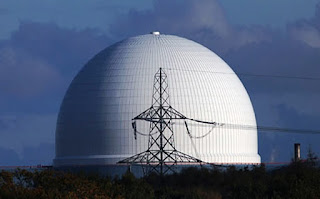Energy Oil and Energy
A nuclear power plant or nuclear power station is a thermal power station in which the heat source is a nuclear reactor. As it is typical of thermal power stations, heat is used to generate steam that drives a steam turbine connected to a generator that produces electricity. As of 23 April 2014, the IAEA report there are 449 nuclear power reactors in operation operating in 31 countries.
Nuclear plants are usually considered to be base load stations since fuel is a small part of the cost of production and because they cannot be easily or quickly dispatched. Their operations and maintenance (O&M) and fuel costs are, along with hydropower stations, at the low end of the spectrum and make them suitable as base-load power suppliers. The cost of spent fuel management, however, is somewhat uncertain.
The conversion to electrical energy takes place indirectly, as in conventional thermal power stations. The fission in a nuclear reactor heats the reactor coolant. The coolant may be water or gas or even liquid metal depending on the type of reactor. The reactor coolant then goes to a steam generator and heats water to produce steam. The pressurized steam is then usually fed to a multi-stage steam turbine. After the steam turbine has expanded and partially condensed the steam, the remaining vapour is condensed in a condenser. The condenser is a heat exchanger which is connected to a secondary side such as a river or a cooling tower. The water is then pumped back into the steam generator and the cycle begins again. The water-steam cycle corresponds to the Rankine cycle.
Nuclear plants are usually considered to be base load stations since fuel is a small part of the cost of production and because they cannot be easily or quickly dispatched. Their operations and maintenance (O&M) and fuel costs are, along with hydropower stations, at the low end of the spectrum and make them suitable as base-load power suppliers. The cost of spent fuel management, however, is somewhat uncertain.
The conversion to electrical energy takes place indirectly, as in conventional thermal power stations. The fission in a nuclear reactor heats the reactor coolant. The coolant may be water or gas or even liquid metal depending on the type of reactor. The reactor coolant then goes to a steam generator and heats water to produce steam. The pressurized steam is then usually fed to a multi-stage steam turbine. After the steam turbine has expanded and partially condensed the steam, the remaining vapour is condensed in a condenser. The condenser is a heat exchanger which is connected to a secondary side such as a river or a cooling tower. The water is then pumped back into the steam generator and the cycle begins again. The water-steam cycle corresponds to the Rankine cycle.
The nuclear reactor is the heart of the station. In its central part, the reactor's core produces heat due to nuclear fission. With this heat, a coolant is heated as it is pumped through the reactor and thereby removes the energy from the reactor. Heat from nuclear fission is used to raise steam, which runs through turbines, which in turn power the electrical generators.
Nuclear reactors usually rely on uranium to fuel the chain reaction. Uranium is a very heavy metal that is abundant on Earth and is found in sea water as well as most rocks. Naturally occurring uranium is found in two different isotopes: uranium-238 (U-238), accounting for 99.3% and uranium-235 (U-235) accounting for about 0.7%. Isotopes are atoms of the same element with a different number of neutrons. Thus, U-238 has 146 neutrons and U-235 has 143 neutrons.
Different isotopes have different behaviors. For instance, U-235 is fissile which means that it is easily split and gives off a lot of energy making it ideal for nuclear energy. On the other hand, U-238 does not have that property despite it being the same element. Different isotopes also have different half-lives. A half-life is the amount of time it takes for half of a sample of a radioactive element to decay. U-238 has a longer half-life than U-235, so it takes longer to decay over time. This also means that U-238 is less radioactive than U-235. More details
